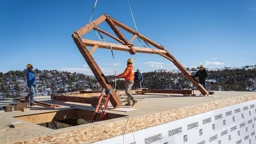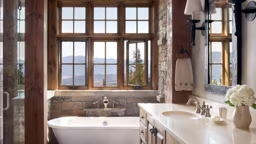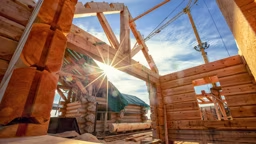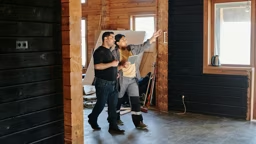 The homeowners weren’t going for a super modern design, but they were looking for something more contemporary. The result: A mountain-style, relaxed getaway.
The homeowners weren’t going for a super modern design, but they were looking for something more contemporary. The result: A mountain-style, relaxed getaway.
Thanks to a well-documented design/build process — and a homeowner’s willingness to share — we’ll follow the Olsen family’s journey from start to finish, and get the inside scoop on exactly what goes on during the custom home building experience. It’s the stuff that fairytales are made of — living in your dream home. A home that speaks to you and draws you in.
As Goldilocks would say, a home that feels “just right.” But how do we dreamers turn into doers, creating legacy homes that are meant just for us? If you’re anything like Greg Olsen, the first thing you’ll need is some time. “When I bought the property almost ten years ago, I knew I just had to have it, but our plans to build got postponed,” he says, explaining that starting construction on a second home during the financial collapse of 2007-2008 just didn’t seem appropriate. “The moment I saw the property, I called my wife and said we’re buying this!” says Greg. “It’s like nothing I’ve ever seen. The views are to die for and the property is almost 100 acres, so the privacy is perfect for us.”
“The moment I saw the property, I called my wife and said we’re buying this!” says Greg. “It’s like nothing I’ve ever seen. The views are to die for and the property is almost 100 acres, so the privacy is perfect for us.”
But that didn’t stop him and his wife Dee from subscribing to Timber Home Living, collecting ideas and even making a folder with all the things that they wanted in a future home. “The dream was always there,” he says. “It wasn’t a matter of ‘if,’ it was ‘when.’ And now is the ‘when.’”
The Dream Team
Located along the border of the Massachusetts Berkshires in upstate New York, the Olsens’ nearly 100-acre property is just a quick two-hour drive from their full-time residence in Manhattan. And the area, according to Greg, is the perfect place for a relaxing weekend house. Surrounded by beautiful scenery, there are places to ride bikes and go hiking, as well as nearby restaurants and shopping. Plus, there’s the community. “There’s no ‘scene,’” Greg explains. “People go up there just to relax — they’re not there to show off their cars.”See also Creating a Country Kitchen
And those good people include the team at New Energy Works Timberframers in Farmington, New York, the company that Greg and Dee decided to work with on their dream-home project. “We obviously loved the timber framing in their homes so much, but quite frankly, during all these years that I’ve been reading Timber Home Living, the New Energy Works homes just jived with the philosophy that my wife and I have for what we want to build,” Greg explains. “The word that Dee and I always come up with is ‘harmony.’ Their homes always seem to have such a good feel for the land and the space, and they’re never over-the-top or too rustic or too modern. It’s right in that sweet spot of a perfect balance.”
Lay of the Land
To strike that perfect balance in their own design, the Olsens worked closely with Ty Allen, who heads the East Coast design group for New Energy Works, to create a plan that would feel at home in the beloved location. “When we first met, I sat with Greg on the site and we talked about how the house might be laid out,” says Allen, “but the reality was the site sort of showed us exactly what we needed to do.” In this particular case, Allen explains, the extraordinary views to the south and to the east dictated that the house needed to look in both of those directions. To do this, the design team positioned the main living areas in the southeast corner of the house, with the kitchen and dining rooms both looking through that space to the east and to the south, taking in the views of nearby Catamount and Butternut Mountains.
In this particular case, Allen explains, the extraordinary views to the south and to the east dictated that the house needed to look in both of those directions. To do this, the design team positioned the main living areas in the southeast corner of the house, with the kitchen and dining rooms both looking through that space to the east and to the south, taking in the views of nearby Catamount and Butternut Mountains. “The view showed us precisely what we should be doing and then it sort of unfolded from there,” Allen says. “They also have this gorgeous pond that looks across to the south, so all of these exterior elements really came together. The view is the driving factor behind the whole house.” And Greg and Dee couldn’t be more pleased with the finished plan. “We just came to Ty with these ideas, pictures and vision, and he draws this sketch of this house, and the moment we looked at it, my wife and I were like, ‘That’s it! That’s the one!’ What he came up with, I couldn’t have imagined better in my head,” he says with a smile. “I’m sitting here looking at the plans right now, and I’m getting misty. I’m just looking forward to it so much.”
 The home boasts ample porch space, most of which is screened to provide some relief for the couple’s daughter who battles severe environmental allergies.
The home boasts ample porch space, most of which is screened to provide some relief for the couple’s daughter who battles severe environmental allergies.

Design Details
While the home’s location certainly dictated a lot of the home’s design, there were a number of other “must haves” that Ty Allen and his team needed to incorporate into the finished layout.1. Well-Placed Walkout
“We knew we had the opportunity for a walkout because of the slope in the site, and we wanted to take advantage of that,” explains Allen. To do this — and to eliminate the need for a second story — the team used the lower level to accommodate kids’ bedrooms, guest rooms, a recreation area and an exercise room, while the upstairs is focused on primary living spaces and the master bedroom suite.2. Initial Approach
In most homes, you approach the home from the driveway along the backside of the house, which is typically opposite of the view. In this case, though, as Allen explains, you approach from the view side and have to drive around to the back of the house to park. “This always presents a little bit of a challenge because you want to enter the house on a main level, not the lower-level walkout,” he says. “How the house positions itself and how it looks from the approach becomes incredibly important because everyone is going to see it on their way in.”See also 9 Steps to the Perfect Timber Frame Floor Plan
3. Passive Solar
“The home boasts a south-facing view, so from a passive solar and energy conservation angle, we really had the best of both worlds,” says Allen. “We had to opportunity to put lots of glass on the south side and work with shading devices to buffer the heat in the summer, but use those windows to grab some solar heat gain in the winter.”4. Large Living Areas
As far as amenities go, the Olsens wanted a really large great room and living area that could feel like a New York City loft. “In this case, the dining area was really important to them,” says Allen. “They wanted to be able to sit in their seats and look to the east and see Catamount and Butternut Mountains. They also wanted a smart design that would accommodate entertaining, while still featuring more modest volumes, with lower, more-intimate spaces.”A Healthy Home
During the planning phase, Greg and Dee Olsen revealed that their daughter has severe environmental allergies, making the need to create a very clean and environmentally-friendly house that much more important. “We’re incorporating as much reclaimed wood as we possibly can and we’re eliminating the use of VOCs,” Greg explains. “We’re examining everything to create the best indoor air quality possible.”The plan is also to switch up some of the insulation, using natural insulating materials, such as cellulose and Roxul, and the heating and ventilation is going to be allergy friendly with the filtration. The design also boasts plenty of outdoor space including screened-in sections that will provide a respite for folks that are allergic to pollens. “The screened porches also become a really nice extension of the inside of the home and allow the interior spaces to flow out, kind of blurring the lines between interior and exterior,” Allen explains.

Home Details
Square footage: 3,286 (including lower level)Bedrooms: 4
Bathrooms: 3.5











